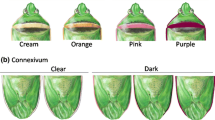Abstract
The relationship between axil age and water-holding capacity on the presence and age of immatures of Aedes (Stegomyia) simpsoni (Theobald) complex (Diptera: Culicidae) in cultivated banana, Musa spp. (Musaceae), Colocasia esculenta and Xanthosoma sagittifolium (Araceae) during the rainy and dry seasons at different locations in Uganda is presented. On Musa spp., higher, younger axils were found to contain more water than older Qnes. In some seasons these axils held more immatures of Aedes simpsoni complex than the lower, older axils of the plant. On C. esculenta and X. sagittifolium plants, the middle and lower axils held more water, and had a greater abundance of larvae and pupae. There were generally no significant differences (P > 0.05) in the mean age of larvae and pupae found in axils of different ages.
Résumé
Les relations entre l’âge des aisselles de feuilles de bananier Musa spp., (Musaceae), Colocasia esculenta et Xanlhomonas sagittifolium (Araceae), et leur capacité de rétention d’eau ainsi que la présence du complexe des stades immatures de Aedes (Stegomyia) simpsoni (Theobald) (Diptera: Culicidae), ont été étudiées au cours des saisons pluvieuse et sèche, en différentes localités de l’Uganda. Il fut remarqué chez le bananier que les aisselles des feuilles supérieures c’est-à-dire les plus jeunes retenaient plus d’eau que les veilles. De même, à certaines saisons, ces aisselles supérieures logeaient plus de stades immatures de A. simpsoni en comparaison des aisselles inférieures. Chez Colocasia esculenta et X. sagittifolium, les aisselles inférieures et moyennes retenaient plus d’eau et logeaient une forte quantité de larves et pupes. Il n’y avait généralement pas de différence significative (P > 0,05) entre l’âge moyen des larves et pupes trouvées dans les aisselles de différents âges.
Similar content being viewed by others
References
Beaver R. A. (1983) The community living in Nepenthes pitcher plants: Fauna and food webs, pp. 129–154. In Phytotelmata: Terrestrial Plants as Hosts for Aquatic Insect Communities (Edited by J. H. Frank and L. P. Lounibos). Plexus Publishing Inc., Medford, New Jersey.
Fish D. (1983) Phytotelmata: Flora and Fauna, pp. 1–27. In Phytotelmata: Terrestrial Plants as Hosts for Aquatic Insect Communities (Edited by J. H. Frank and L. P. Lounibos). Plexus Publishing Inc., Medford, New Jersey.
Fish D. and Hall D. W. (1978) Succession and stratification of aquatic insects inhabiting the leaves of the insectivorous pitcher plants, Sarracenia purpurea. American Midland Naturalist 99, 172–183.
Gibbins E. G. (1942) On the habits and breeding habitats of Aedes (Stegomyia) simpsoni Theobald in Uganda. Ann. Trop. Med. Parasitol. 36, 151–160.
Haddow A. J. (1948) The mosquitoes of Bwamba County, Uganda. VI. Mosquito breeding in plant axils. Bull. Entomol. Res. 39, 185–212.
Huang Y. M. (1986) Aedes (Stegomyia) bromeliae (Diptera: Culicidae), the yellow fever virus vector in East Africa. J. Med. Entomol. 23, 196–200.
Lutwama J. J. (1991) Studies on the ecology and biosystematics of Aedes (Stegomyia) simpsoni Theobald (Diptera: Culicidae). PhD Thesis, Makerere University, Kampala, Uganda. 240 pp.
Lutwama J. J. and Mukwaya L. G. (1995) Esimates of mortalities of larvae and pupae of the Aedes simpsoni (Theobald) (Diptera: Culicidae) complex in Uganda. Bull. Entomol. Res. 85, 93–99.
Machado-Allison C. E., Rodriguez D. J., Barrera R. and Gomez-Cova C. (1983) The insect community associated with inflorescence of Heliconia caribeae. pp. 247–270. In Phytotelmata: Terrestrial Plants as Hosts for Aquatic Insect Communities (Edited by J. H. Frank and L. P. Lounibos). Plexus Publishing Inc., Medford, New Jersey.
Mogi M., Horio M., Miyagi I. and Cabrera B. D. (1985) Succession, distribution, overcrowding and predation in the aquatic community in aroid axils with special reference to mosquitoes, pp. 95–119. In Ecology of Mosquitoes: Proceedings of a Workshop (Edited by L. P. Lounibos, J. A. Rey and J. H. Frank) Florida Medical Laboratory, Vero Beach.
Pajot F. X. (1975) Contribution a l’etude écologique d’Aedes (Stegomyia) simpsoni (Theobald, 1905) (Diptera: Culicidae). Etude dés gites larvires en Republique Centrafricaine. Call. ORSTOM Series Entomol. Med. Parasitol. 13, 31–48.
Seifert R. P. (1980) Mosquito fauna of Heliconia aurea. Anim. Ecol. 49, 687–697.
Teesdale C. (1957) The genus Musa Linn, and its role in the breeding of Aedes (Stegomyia) simpsoni (Theo.) on the Kenya Coast. Bull. Entomol. Res. 48, 251–260.
Author information
Authors and Affiliations
Corresponding author
Rights and permissions
About this article
Cite this article
Lutwama, J.J. Seasonal Distribution of Aedes (Stegomyia) simpsoni (Theobald) Immatures in Plant Axils of Araceae and Musaceae in Uganda. Int J Trop Insect Sci 18, 105–112 (1998). https://doi.org/10.1017/S1742758400007736
Accepted:
Published:
Issue Date:
DOI: https://doi.org/10.1017/S1742758400007736




